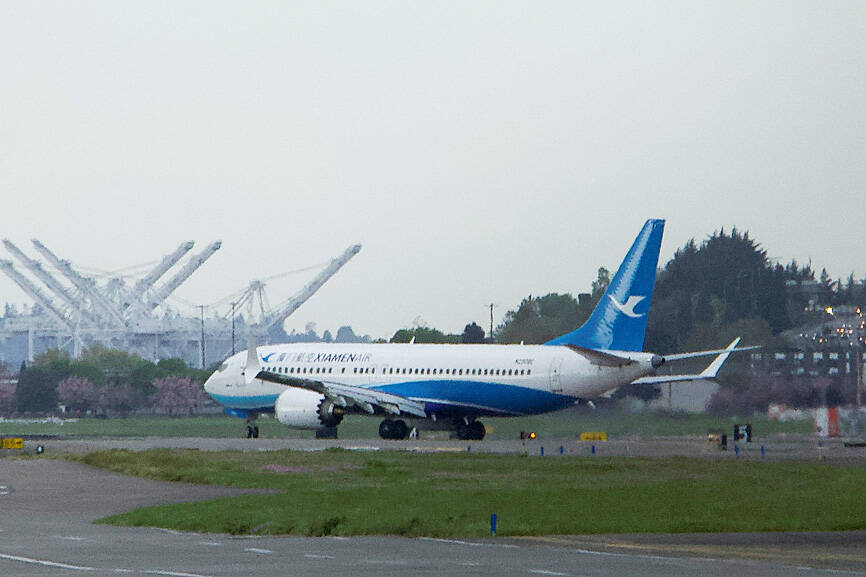A Boeing Co jet intended for use by a Chinese airline landed back at the planemaker’s US production hub yesterday, a victim of the tit-for-tat bilateral tariffs launched by US President Donald Trump in his global trade offensive.
The 737 MAX, which was meant for China’s Xiamen Airlines, landed at Seattle’s Boeing Field at 6:11pm, according to a Reuters witness. It was painted with the XiamenAir livery.
The jet, which made refueling stops in Guam and Hawaii on its 8,000km return journey, was one of several 737 MAX jets waiting at Boeing’s completion center in Zhoushan, China, for final work and delivery to a Chinese carrier.

Photo: REUTERS
Trump this month raised baseline tariffs on Chinese imports to 145 percent. In retaliation, China has imposed a 125 percent tariff on US goods. A Chinese airline taking delivery of a Boeing jet could be crippled by the tariffs, given that a new 737 MAX has a market value of around US$55 million, according to aviation consultancy IBA Group Ltd.
It is not clear which party made the decision for the aircraft to return to the US. Boeing and XiamenAir did not respond to requests for comment.
The return of the 737 MAX, Boeing’s best-selling model, is the latest sign of disruption to new aircraft deliveries from a breakdown in the aerospace industry’s decades-old duty-free status.
Confusion over changing tariffs could leave many aircraft deliveries in limbo, with some airline CEOs saying they would defer delivery of planes rather than pay duties.
Moreover, commercial plane prices, already lifted in recent years due to pandemic supply chain shocks, are poised to climb further as Boeing and Airbus SE are buffeted by trade tariffs.
“Compared with 2018, prices for commercial jets have risen by around 30 percent,” an aviation expert told AFP on condition of anonymity.
The US and European aerospace giants have grappled with higher expenses for primary materials such as titanium, components and energy, as well as overall labor cost pressures.
Richard Aboulafia, managing director at consultancy AeroDynamic Advisory LLC, said items that have inflated “at a particularly high rate” include castings, forgings and “anything titanium... especially since all that Russian capacity has been cut off from the US and, to a lesser extent, from Europe.”
Aboulafia estimates prices for materials and equipment have risen 40 percent since 2021. That was before Trump’s 25 percent tariffs on steel and aluminum, which are used in planes.
“It’s kind of ironic, raw materials were not a problem, but Donald Trump is determined to make them a problem,” Aboulafia said.
Inflation in aviation has been accelerating, and “that’s only going to get worse with these tariffs that are being imposed,” Aircraft Value News editor-in-chief John Persinos said. “These tariffs are disastrous.”
Additional reporting by AFP

UNCERTAINTY: Innolux activated a stringent supply chain management mechanism, as it did during the COVID-19 pandemic, to ensure optimal inventory levels for customers Flat-panel display makers AUO Corp (友達) and Innolux Corp (群創) yesterday said that about 12 to 20 percent of their display business is at risk of potential US tariffs and that they would relocate production or shipment destinations to mitigate the levies’ effects. US tariffs would have a direct impact of US$200 million on AUO’s revenue, company chairman Paul Peng (彭雙浪) told reporters on the sidelines of the Touch Taiwan trade show in Taipei yesterday. That would make up about 12 percent of the company’s overall revenue. To cope with the tariff uncertainty, AUO plans to allocate its production to manufacturing facilities in

Taiwan will prioritize the development of silicon photonics by taking advantage of its strength in the semiconductor industry to build another shield to protect the local economy, National Development Council (NDC) Minister Paul Liu (劉鏡清) said yesterday. Speaking at a meeting of the legislature’s Economics Committee, Liu said Taiwan already has the artificial intelligence (AI) industry as a shield, after the semiconductor industry, to safeguard the country, and is looking at new unique fields to build more economic shields. While Taiwan will further strengthen its existing shields, over the longer term, the country is determined to focus on such potential segments as

COLLABORATION: Given Taiwan’s key position in global supply chains, the US firm is discussing strategies with local partners and clients to deal with global uncertainties Advanced Micro Devices Inc (AMD) yesterday said it is meeting with local ecosystem partners, including Taiwan Semiconductor Manufacturing Co (TSMC, 台積電), to discuss strategies, including long-term manufacturing, to navigate uncertainties such as US tariffs, as Taiwan occupies an important position in global supply chains. AMD chief executive officer Lisa Su (蘇姿丰) told reporters that Taiwan is an important part of the chip designer’s ecosystem and she is discussing with partners and customers in Taiwan to forge strong collaborations on different areas during this critical period. AMD has just become the first artificial-intelligence (AI) server chip customer of TSMC to utilize its advanced

While China’s leaders use their economic and political might to fight US President Donald Trump’s trade war “to the end,” its army of social media soldiers are embarking on a more humorous campaign online. Trump’s tariff blitz has seen Washington and Beijing impose eye-watering duties on imports from the other, fanning a standoff between the economic superpowers that has sparked global recession fears and sent markets into a tailspin. Trump says his policy is a response to years of being “ripped off” by other countries and aims to bring manufacturing to the US, forcing companies to employ US workers. However, China’s online warriors